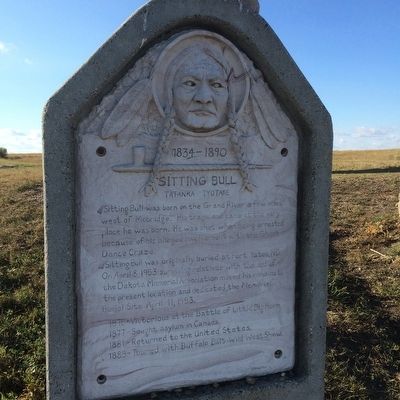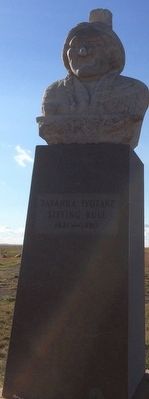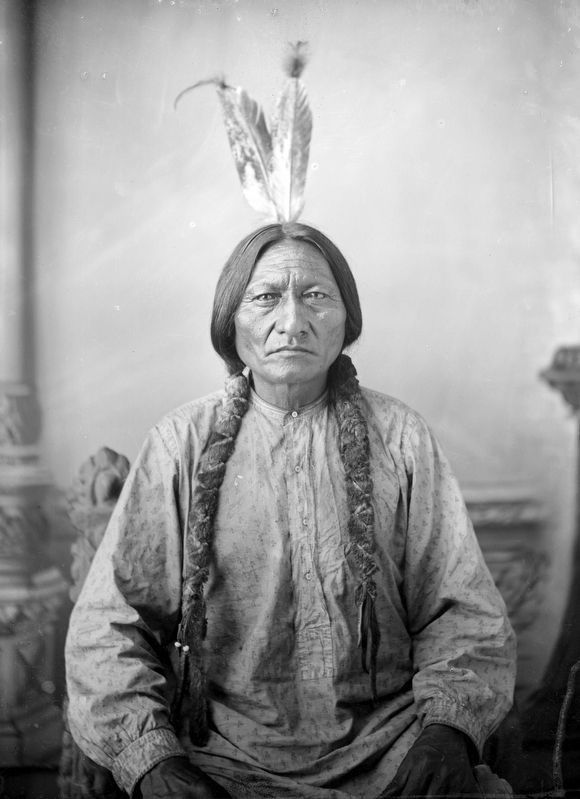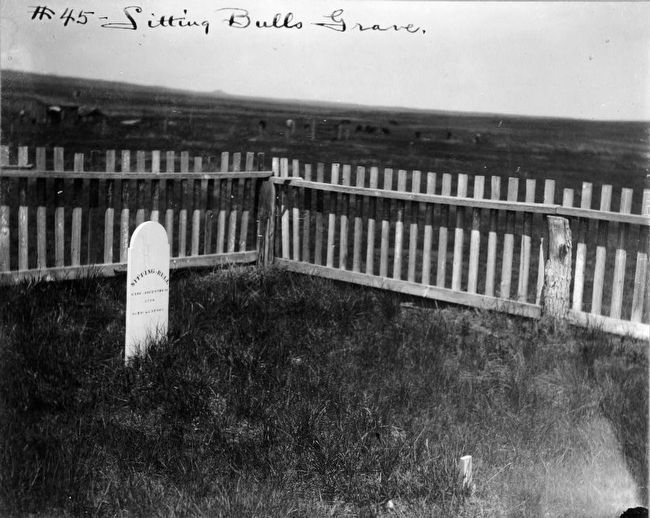Near Mobridge in Corson County, South Dakota — The American Midwest (Upper Plains)
Sitting Bull
Tatanka Iyotake
— 1834 - 1890 —
Sitting Bull was born on the Grand River a few miles west of Mobridge. His tragic end came at the very place he was born. He was shot when being arrested because of his alleged involvement with the Ghost Dance craze.
Sitting Bull was originally buried at Fort Yates, ND. On April 8, 1953 surviving relatives with the aid of the Dakota Memorial Association moved his remains to the present location and dedicated the Memorial Burial Site April 11, 1953.
1877 - Sought asylum in Canada.
1881 - Returned to the United States. 1885 - Toured with Buffalo Bill's Wild West Show.
Erected by Dakota Memorial Association.
Topics. This historical marker is listed in these topic lists: Native Americans • Wars, US Indian. A significant historical date for this entry is December 15, 1890.
Location. 45° 31.011′ N, 100° 29.11′ W. Marker is near Mobridge, South Dakota, in Corson County. Marker can be reached from State Highway 1806, 4 miles south of U.S. 12. State Hwy 1806 is pavement to the memorials. Past the memorial the road turns to gravel. Touch for map. Marker is in this post office area: Mobridge SD 57601, United States of America. Touch for directions.
Other nearby markers. At least 8 other markers are within 3 miles of this marker, measured as the crow flies. Sakakawea (about 800 feet away, measured in a direct line); Honored Leaders (approx. 2.3 miles away); A Final Resting Place (approx. 2.3 miles away); Lewis and Clark Expedition (approx. 2.3 miles away); "Sakakawea and Lewis & Clark" (approx. 2.4 miles away); "they just did a man's job" (approx. 2.4 miles away); River of Hardship (approx. 2.4 miles away); Lewis & Clark meet the Arikaras (approx. 2.4 miles away). Touch for a list and map of all markers in Mobridge.
More about this marker. There is a Monument to Sitting Bull located nearby.
Also see . . .
1. Gravesites of Sitting Bull. (Submitted on November 12, 2015, by Ruth VanSteenwyk of Aberdeen, South Dakota.)
2. Wikipedia entry for Sitting Bull.
Sitting Bull (Lakota: Tȟatȟáŋka Íyotake) (c. 1831–1890) was a Hunkpapa Lakota leader who led his people during years of resistance against United States government policies. He was killed by Indian agency police on the Standing Rock Indian Reservation during an attempt to arrest him, at a time when authorities feared that he would join the Ghost Dance movement. ...(Submitted on December 12, 2020.)
Around 5:30 a.m. on December 15, 39 police officers and four volunteers approached Sitting Bull’s house. They surrounded the house, knocked and entered. Lieutenant Henry Bullhead told Sitting Bull that he was under arrest and led him outside. Sitting Bull and his wife noisily stalled for time: the camp awakened and men converged at the house. As Bullhead ordered Sitting Bull to mount a horse, he said the Indian Affairs agent wanted to see the chief, and then Sitting Bull could return to his house. When Sitting Bull refused to comply, the police used force on him. The Sioux in the village were enraged. Catch-the-Bear, a Lakota, shouldered his rifle and shot Bullhead, who reacted by firing his revolver into the chest of Sitting Bull. Another police officer, Red Tomahawk, shot Sitting Bull in the head, and Sitting Bull dropped to the ground. Sitting Bull died between 12 and 1 p.m.
A close-quarters fight erupted, and within minutes, several men were dead. The Lakota killed six policemen immediately, while two more died shortly after the fight, including Bullhead. The police killed Sitting Bull and seven of his supporters at the site, along with two horses.
Credits. This page was last revised on December 12, 2020. It was originally submitted on November 12, 2015, by Ruth VanSteenwyk of Aberdeen, South Dakota. This page has been viewed 1,084 times since then and 62 times this year. Last updated on December 4, 2018, by Ruth VanSteenwyk of Aberdeen, South Dakota. It was the Marker of the Week December 13, 2020. Photos: 1, 2. submitted on November 12, 2015, by Ruth VanSteenwyk of Aberdeen, South Dakota. 3. submitted on December 12, 2020, by J. J. Prats of Powell, Ohio. 4. submitted on November 13, 2015. • Andrew Ruppenstein was the editor who published this page.



